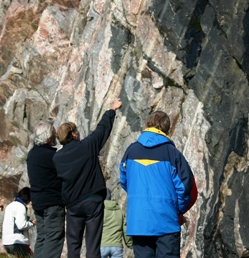
I would like to thank my co-conveners, Maarten Krabbendam, Rick Law, Rob Strachan and Bob Holdsworth, together with the Society’s Conference Office for support in getting this meeting together. The additional field trip leaders including the Lewisian all-stars (Graham Park, Rod Graham, Alistair Beach and John Wheeler) together with Kathryn Goodenough, Graham Leslie and Ryan Thigpen, were invaluable in getting a bunch of argumentative and challenging visitors, ranging from long-in-the-tooth aficionados to complete newcomers, over the Highland geology. Ryan deserves special mention for editing the field guide. Chris and Fran at the Macphail Centre are to be congratulated for running such a fantastic facility that doubtless will be used many more times for international conferences. The whole village seemed to be mucking in to make our stay run smoothly. Financial support came from our sponsors (Hess, BG, Shell, Encana, BP, Exxon Mobil and the Highland Council) and in kind from our host institutions.
We thought it important to leave a legacy from the meeting. Jack Soper donated a copy of the Memoir (dedicated to a previous owner by Sir Edward Battersby Bailey) to Ullapool library. The conference website (
www.see.leeds.ac.uk/peachandhorne) remains live for anyone to access the abstracts, download the field guide or take a look at the gallery of images from the meeting.
In parallel, there is an exhibition of the Survey’s old mapping and related materials, premiered in Ullapool during the conference, moving to Edinburgh and Glasgow (
www.mappingmountains.com ) through the summer, that continues to link the geology to the public. And finally, there will be a collection of research papers.
On that note, the meeting brought together the geochronological and field-based sides of the Lewisian terrane debate. In an act of conflict resolution, they went into the field together after the official Lewisian outing and are now planning a joint paper.
Scottish geology remains a live area for scientific endeavour - Peach and Horne would have approved.
Rob Butler, University of Leeds